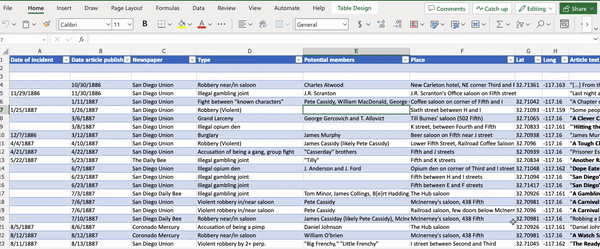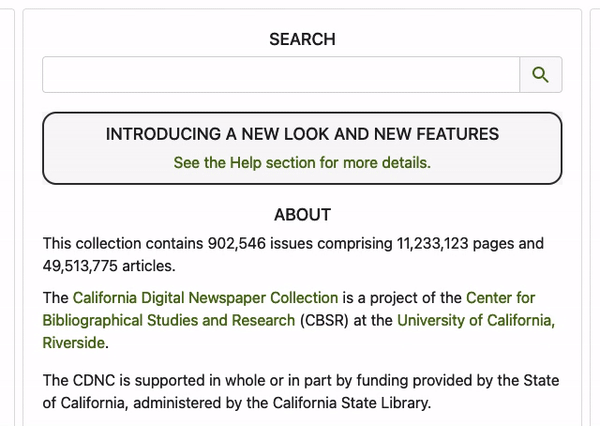Making the Organized Crime Map
1. Defining the area and time period. Here, I decided to focus on streets below F and above K (incl. addresses on F or K) and between First and Tenth (also incl. addresses on First or Tenth). The Health Department considered the area between First and Fifth, Market (H street) and K (See McPhail’s summary of the district), but I have chosen to stretch those boundaries to reflect the prevalence of organized crime in the surrounding area as it shifted over time. The map also only covers the years between 1880-1912, as the size of the town pre-1880 was incredibly small and 1912 being the year in which the women of the Stingaree were forced out by the city.
2. Identifying the criteria. Going by Encyclopedia Britannica’s definition of organized crime, I have identified my criteria as such:
- Robberies with more than one perpetrator or accomplice
- Robberies in and around bars
- Violent robberies
- Illegal opium dens and gambling parlors
- Large street fights
- Crimes facilitated by employees of saloons/proprietor(s)
- Counterfeiting and (some cases of) embezzlement
- Pimping or pandering
- Safe cracking
I did not include property crime (i.e. stealing from someone’s room/trunk/house), sex work, or the existence of benevolent societies in the list. Fights and random assaults, too, are not included, as they do not meet the criteria.
3. Creating Excel sheets to contain the data. From left to right, my columns include:
- Date of incident
- Date article published
- Newspaper name
- Type of incident (i.e. violent robbery, illegal gambling joint)
- Potential members
- Place
- Latitude
- Longitude
- Article text
- Article source (which repository the article came from, not the newspaper)
- Link to article
- Link direct to image of article
- Overflow image link (i.e. the image of the article was large enough that it needed to be split into two parts)
- Link to city directory where address was found
- Any additional information justifying why I placed the point there and/or outcome of case
- Link to outcome of case

I did this for each decade (3 sheets), and used similar format for collection data on allegations of corruption (another 3 sheets, one for each decade). I included two more sheets as well– one for shut-downs and attempts at shutdowns, and one for allegations of corruption/organized crime that were printed in non-newspaper publications (or not published at all). The data will not ever be, by any means, complete, but I will continue to update it as I come across more articles.
4. Searching. The search is the part that I find the most enjoyable. I used the following repositories for my research:
- California Digital Newspaper Collection from the Center for Biographical Studies and Research at University of California, Riverside.
- Genealogy Bank (paid service, so no images of articles sourced from here can be included due to rights restrictions)
I also google many of the names of establishments/people so as to see if anything else has been written in regards to their involvement in organized crime. Though I occasionally use Newspapers.com (free with a Carlsbad Library card) for research on individual names, the lack of San Diego newspapers in their collection make it unhelpful for finding information about local crime.
Wildcard keys are essential when searching through large amounts of OCR generated text. Searches for “Stingaree” may only yield a few hundred results, for example, but a search for “S???garee” or “Sting*e” will widen the pool to thousands.

To list all the keywords I’ve searched, and to distinguish them from other biographical research and tangents I’ve gone on, would take a very, very long time. As you can see in the above gif, my computer has a hard time even processing the previous search history when I attempt to drag the bar down. Also, in the links included to newspaper articles, the keyword I found the article under can often be found in the address to the article.
There’s no real way to narrow down these thousands that might get brought up by using wildcard searches, or searches for a general sounding name. However, if you narrow by time period and remove results as well, using (-) to take something out of the search, you make for a much more enjoyable time in researching. CDNC also has a helpful feature that, at least on San Diego papers, works fairly well, in which the Optical Character Recognition software will separate the advertisements and articles for you so you’re not getting hundreds of the same result.
I might add that, although a good 96% of my project has been conducted using digital archives, a microfilm article or document that I have previously found at the San Diego Central Library or at the San Diego History Center will be included (with consideration for copyright, of course— no images or words from anything owned by the San Diego History Center will be used, as they retain the copyright to their collection.)
5. Adding the Excel sheets to ArcGIS. Once my Excel sheets were complete, I added them as layers on an ArcGIS map. I tried to make everything look as tidy as possible, but besides the obvious overload of information, I’m having a problem with getting the dates on the pop-ups to go chronologically as you click through them. I understand it is because I’m using multiple Excel sheets (so that the data can be viewed by decades with the layers feature, as the sliding timeline is unavailable) but I was hoping there was a way to make the software see the dates and sync them to some sort of a universal calendar.
(Not included yet is the layer with the 1888 Sanborn maps for San Diego from Library of Congress, which I combined into a larger map using Adobe Photoshop)
Finding People
The first step to this portion of the process, of course, is deciding who to research. Once I find a name, I search for the name and names like it (i.e. in looking for a “Marie Smith,” you’d also want to look up “Mary Smith”) on both the aforementioned newspaper repositories and genealogy databases. Though my personal favorite is Ancestry.com, Family Search is free and has many records that are missing from Ancestry.com, making it helpful for filling in the gaps (and researching any international connections, as Ancestry charges an additional fee for international records access on top of their regular membership fee). (Also, I do want to add that Family Search is far from secular.)
Some things to keep in mind as you search:
- Finding the life histories of white people who were engaged in sex work in the past is already challenging, but looking for Black, Asian, Indigenous and Latina people who were working in the Stingaree district has proved even more difficult to research. The reasons for this, of course, are too numerous to list, but in short, the general lack of respect and cultural understanding led to both the accidental and purposeful misspelling of names, not to mention the frequency at which last names have been left out for POC (i.e. census records for Indigenous persons often didn’t have last names recorded).
- I hope to more adequately represent the stories of these women in the future, but there is a definite over-representation of white women in my research at this point of time, and I’d like to acknowledge that as not necessarily being reflective of the women who worked in the Stingaree as a whole.
- Nicknames and alias are common when researching people in the past, but even more so when you look at the criminal underworld. Joshua Camp, for example, traced Pete Cassidy (a man who appears on my Stingaree organized crime map perhaps more than any other figure) all the way back to Illinois, where he was once arrested for safe breaking and served time in Joliet prison under his true name- Patrick Cavanaugh.
- Similar vital information (i.e. birth date/place, parent’s birth place, siblings) can be used to correlate these identities. In this case, “Patrick Cavanaugh” was born in the same place as Pete Cassidy, in the same year, to a mother that later moved to San Diego and was identified as “Bridget Cavanaugh” in the newspapers when she passed away. Both “Patrick” and “Pete” have a slightly older brother named Dan, as well a tendency to commit violent crimes.
- For women, it is obviously much more difficult to do this. Maiden names become married names, and many women I have researched for this project were married more than once. As a result, many of the women I have been able to trace share a few of these characteristics:
- Remained in the same area for a large portion of their lives and had family in the area
- Had their “true name” revealed to the police/press (in most cases, as a result of trials in regards to their “ruin”)
- Owned property
- Maintained an alias for multiple years (“Ruby Grant,” “Rickey” Bowman, “English Liz”)
- Having a child (realistically, a son) that continued to live with them, preserving the last names of their former marriage(s)
- Be prepared to be wrong, and don’t blindly trust the assumptions that others have made. You will be wrong sometimes, and that’s okay! That being said, I think making your own mistakes is better than assuming some else’s family history site or profile is always correct. On many genealogy sites, you’ll run into family trees in which someone accidentally added an incorrect life event due to the mixing of records belonging to separate people that could be easily confused for each other, leading to a life summary that could go, for example: born 1827, died 1870, and here’s his draft card for WW2. Yeah, no.
- In the context of this project, this list also includes things such as 1. assuming an alias is always unique to the person in question you are researching, 2. assuming multiple alias are not used.
- That is not to say that there are not many incredible amateur genealogists working on their family trees. I can’t forget to mention how much of a help it has been to have had both the wonderfully informative conversations I have had with descendants who are active on genealogy platforms as well as access to the general information added to their ancestor’s “profiles” (i.e. photos, bible records).
- Women (and men, to some extent) constantly lied to census takers and record issuers about their age. Be prepared to see some age creep, but always ask yourself if it would have been believable to the recorder.
- i.e. let’s say you had previously established that a woman was born in 1864. It would make sense, then, that she could have easily claimed that she was born in 1870 at the time of the 1900 census. However, if the woman were to have claimed she was born in 1880 or later, you can be fairly confident that the census taker was not mistaking a woman in her late thirties for a twenty-something or teenager, meaning the records of the two women (the one you’re looking for born in 1864 and the woman in the census record from 1900) would not match.
- In many cases, not all marriages were formally recorded, and not every use of a surname indicates that they were still with the person from whom it came.